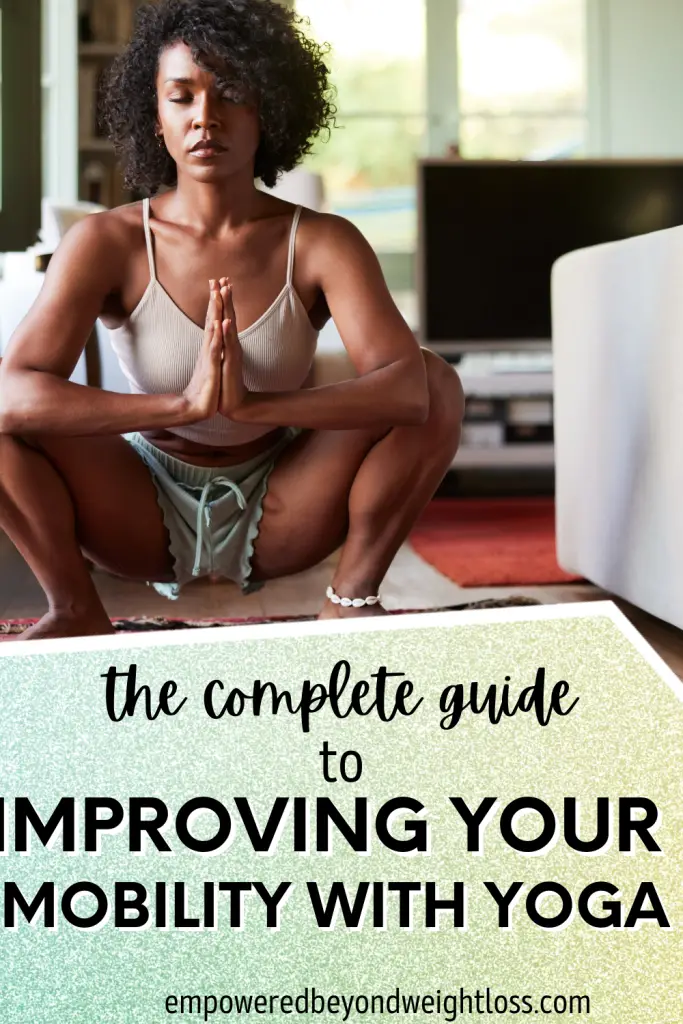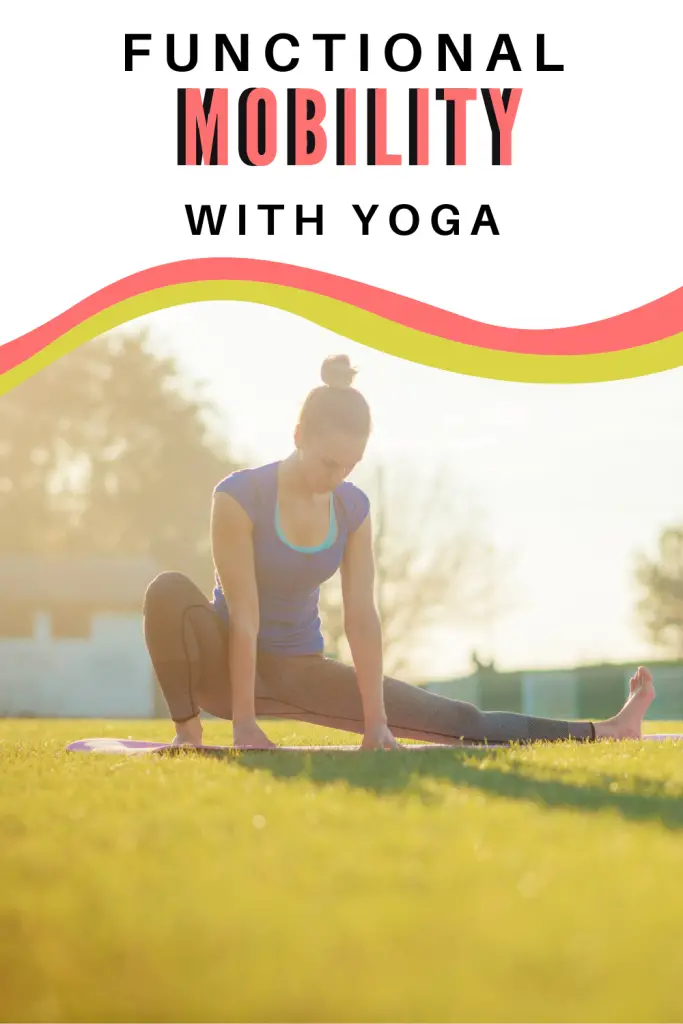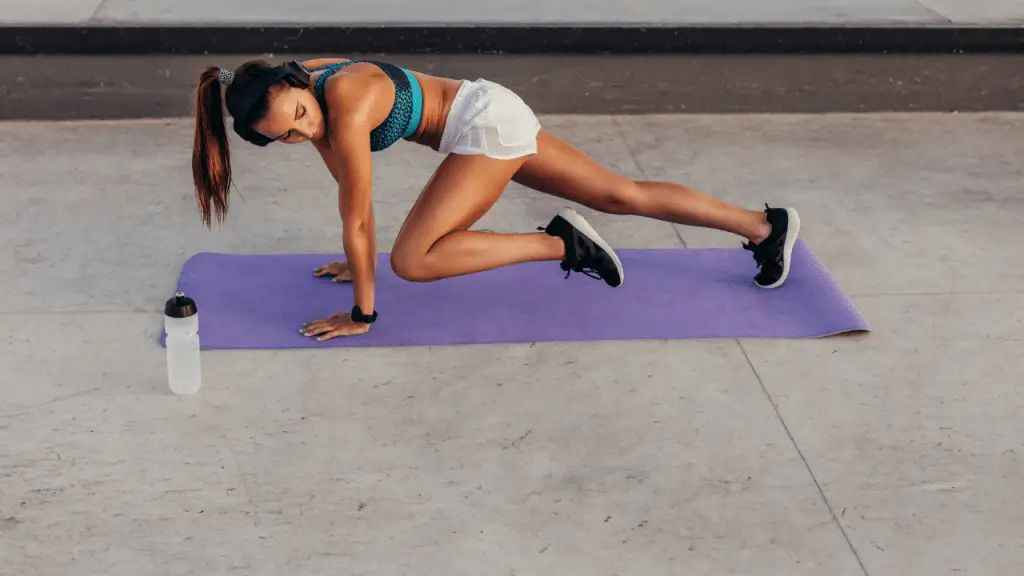In today’s functional mobility workout, I include some of my favorite yoga-inspired mobility exercises. Plus, I explain what functional mobility is and how it can benefit your everyday life.
Functional Mobility Workout
My approach to using yoga for mobility is integrating poses that will increase your strength, flexibility, and balance. I have seen many mobility workouts that focus on moving quickly while doing complicated exercises. That is not what I want for you! We are doing simple combinations that yield results. What’s the point of doing a workout you can’t follow? Plus, we don’t waste time and stick to quick routines because I understand that knowing that your workout is only 15 minutes long helps you stay consistent. And guess what? Consistency is your best ally. Follow along with my full-length video functional mobility workout, or try the following functional mobility exercises inspired by yoga:
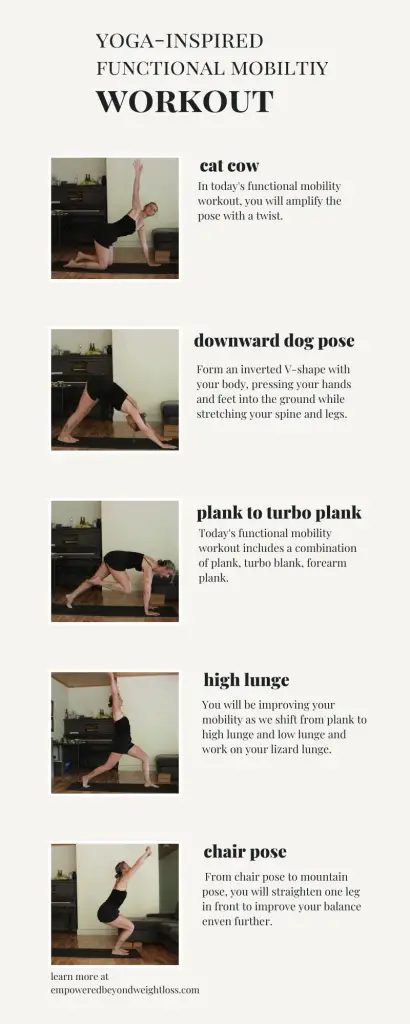
Yoga-Inspired Functional Mobility Exercises
Here are some yoga poses that make excellent functional movement exercises for beginners:
- Cat-Cow (Marjaryasana-Bitilasana): Start on all fours with your hands under your shoulders and knees under your hips. Inhale and arch your back, lifting your chest and tailbone while dropping your belly towards the ground (cow pose). Exhale and round your spine, tucking your tailbone and chin while drawing your belly in (cat pose). In today’s functional mobility workout, you will amplify the pose with a twist.
- Downward Dog (Adho Mukha Svanasana) with Calf Raises: Begin in a plank position, then lift your hips up and back to form an inverted V-shape. Press your heels towards the ground and alternate, raising each heel off the floor while keeping the other heel grounded. This exercise helps stretch the back of the legs and strengthens the calves. Try lowering in dolphin pose to increase your strength and flexibility.
- Chair Pose (Utkatasana) with Arm Reach: Stand with your feet hip-width apart, bend your knees, and lower your hips into a seated position as if sitting on an imaginary chair. Extend your arms overhead, reaching towards the ceiling. This exercise strengthens the lower body and improves balance.
- Plank to Lizard Lunge pose (Utthan Pristhasana): start in a high plank position and bring your right foot forward towards the outside of your right hand, aligning the knee over the ankle. Lower your forearms to the ground inside the right leg, with your elbows directly under the shoulders. Keep the back leg extended and active, allowing the hip flexors and groin to open gently. You can stay on the forearms or onto the hands for a deeper stretch. Breathe deeply and sink into the pose, feeling the release and opening in the hips.
- Spinx pose (Salamba Bhujangasana): lace your elbows under your shoulders, forearms resting on the ground parallel to each other, and palms facing down. Pressing your forearms into the ground, lift your chest and head, allowing the lower body to relax. Keep your shoulders relaxed and draw the shoulder blades down the back, creating a gentle opening in the chest. Lengthen the spine and engage the core for support. Breathe deeply and hold the pose, feeling a gentle stretch along the front body. Sphinx Pose helps to improve posture, relieve lower back tension, and stimulate the digestive organs while promoting a sense of openness and calmness.
- Locust Pose (Salabhasana): As you inhale, lift your chest, arms, and legs off the ground simultaneously, using your back muscles to lift. Keep your gaze forward and lengthen through the crown of your head while actively pressing your pubic bone into the ground. Engage your glutes and legs, reaching them back and up to create a sense of extension. Breathe deeply and hold the pose, feeling the activation and strengthening of the back muscles.
- High Lunge (Utthita Ashwa Sanchalanasana): From chair pose, step one foot back, creating a long stance. Bend the front knee to a 90-degree angle, ensuring that the knee is directly above the ankle. The back leg is extended, with the heel lifted and the toes pressing into the ground. Engage the core and lengthen the spine as you reach the arms overhead, palms facing each other, or coming into prayer position. Relax the shoulders away from the ears and gaze forward. Breathe deeply and hold the pose, feeling the stretch in the hip flexors and the activation of the leg muscles. High Lunge strengthens the legs, improves stability, and stretches the groin and hip flexors, promoting overall lower body strength and flexibility.
As you will see in my full-length video, we move seamlessly between poses, to improve your functional mobility. You will find it is a strength and mobility workout.
Functional Mobility Video Routine
Try this functional mobility workout to increase your mobility. The key is to be consistent. I encourage you to work out every day even if it is for only 5-15 minutes a day. You can also try Best Yoga for Mobility: Strength and Flexibility Flow and How to Increase Hip Mobility: Try These Drills!.
What is Functional Mobility?
Maybe you are not quite sure about the meaning of functional mobility. Let me explain.
Functional mobility is the ability to move and perform everyday tasks easily and efficiently. It involves integrating various physical components, including strength, flexibility, coordination, balance, and range of motion, to carry out activities such as walking, bending, reaching, and lifting. Functional mobility is essential for maintaining independence and participating in daily activities at home, work, and in the community. It encompasses movements and actions that are directly applicable to real-life situations, allowing you to navigate your environment, engage in recreational activities, and perform essential tasks required for self-care and productivity. Improving functional mobility often involves targeted exercises and movements that enhance specific physical abilities and improve overall functional capacity.
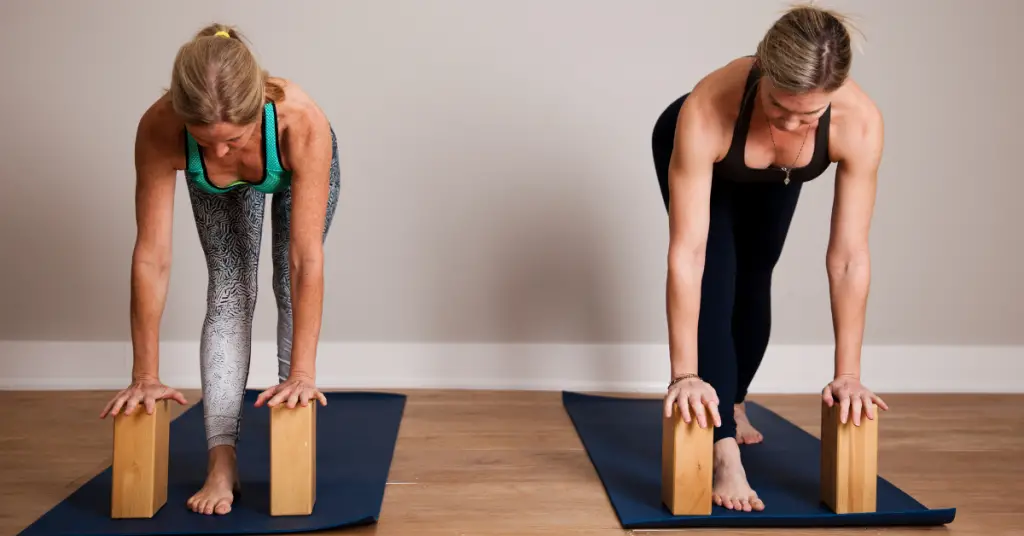
Essential Tips to Improve Your Functional Mobility
Here are some tips to help improve functional mobility:
- Incorporate regular physical activity: Engage in various exercises focusing on strength, flexibility, balance, and cardiovascular fitness. Include activities such as walking, swimming, cycling, yoga, and resistance training to enhance functional mobility. Yoga is the perfect activity that will improve your strength, balance, flexibility, and coordination.
- Practice functional movements: Perform exercises that mimic the movements you encounter in daily life. This could include squats, lunges, bending, reaching, and lifting. Gradually increase the complexity and difficulty of these movements to challenge and improve your functional abilities. You will find these movements in my routines.
- Focus on core strength: A strong core provides a stable base for movement and helps improve balance and stability. Include exercises that target the core muscles, such as planks, bridges, and rotational exercises. Try these Crazy Effective Hip Flexor Strengthening Exercises and Best Yoga Core and Upper Body Workout at Home: Full 20-Minute Routine.
- Stretch regularly: Maintain or improve flexibility by incorporating regular stretching exercises. Pay particular attention to areas such as the hips, shoulders, and hamstrings, as these can impact functional mobility. Yoga and gentle stretching routines can be beneficial. You may enjoy How to Get Flexible With Yoga With Follow-Along Video.
- Work on balance and proprioception: Perform exercises that challenge your balance and proprioception (the sense of your body’s position in space). This can include standing on one leg, using balance boards or stability balls, and practicing yoga poses that require balance.
- Gradually increase the challenge: Continuously challenge your body to improve functional mobility. Increase the intensity, duration, or difficulty of your exercises gradually over time. This progressive approach allows your body to adapt and improve without risking injury.
- Seek professional guidance: Consult with a physical therapist or a qualified fitness professional who can assess your specific needs and create a tailored exercise program to improve functional mobility. They can provide guidance on proper form, technique, and progressions.
- Stay consistent: Consistency is key to improving functional mobility. Aim for regular exercise sessions, even if they are shorter in duration. Set realistic goals and make a commitment to follow through with your exercise routine.
Remember to listen to your body and progress at your own pace. Sign up for my 5-Day Yoga Habit Challenge to work on consistency.
How Mobility Helps With Healthy Aging
You probably already know that moving your body is key to feeling amazing at any age.
Mobility also plays a crucial role in healthy aging by promoting physical independence, overall well-being, and quality of life. Here are some ways mobility contributes to healthy aging:
- Maintaining independence: Good mobility allows older adults to perform daily activities independently, such as walking, climbing stairs, and getting in and out of chairs or beds. By preserving mobility, older adults can continue to live an active and self-sufficient lifestyle.
- Fall prevention: Mobility exercises that focus on balance, coordination, and strength can help reduce the risk of falls, which is a significant concern for older adults. By improving balance and stability, mobility training can enhance confidence and reduce the likelihood of falls and fall-related injuries.
- Managing chronic conditions: Regular physical activity and mobility exercises can help manage and prevent various chronic conditions commonly associated with aging, such as arthritis, osteoporosis, heart disease, and diabetes. Exercise can improve joint mobility, reduce pain and stiffness, enhance cardiovascular health, and support overall disease management.
- Preserving cognitive function: Research suggests a strong link between physical activity, mobility, and cognitive health. Engaging in regular mobility exercises can help maintain cognitive function and reduce the risk of cognitive decline and neurodegenerative diseases, such as dementia and Alzheimer’s disease.
- Enhancing mental well-being: Physical activity and mobility exercises have been shown to have positive effects on mental health and well-being. They can reduce symptoms of depression and anxiety, improve mood, boost self-esteem, and promote better sleep quality.
- Improving cardiovascular health: Maintaining good mobility through regular exercise helps improve cardiovascular health by increasing heart and lung function, reducing the risk of cardiovascular diseases, and lowering blood pressure and cholesterol levels.
- Enhancing bone and muscle health: Weight-bearing exercises and strength training activities as part of mobility routines help improve bone density, preserve muscle mass, and reduce the risk of age-related muscle loss (sarcopenia). Strong bones and muscles contribute to overall mobility, balance, and injury prevention.
- Social engagement and participation: Being mobile and physically active allows older adults to engage in social activities, maintain social connections, and participate in community events. This contributes to a sense of belonging, purpose, and overall happiness.
By focusing on mobility and engaging in regular physical activity, older adults can optimize their overall health, maintain independence, reduce the risk of chronic conditions, and enhance their overall quality of life as they age.
In Summary
Do today’s functional mobility workout regularly. Also, focus on increasing your strength and flexibility using my other routines. You will notice a decrease in pain, you will feel strong and energized. One last thing to keep in mind is that if you are still like I was when I got started, you may benefit from following my roadmap to increasing your flexibility, which is my Full-Body Flexibility Transformation.
